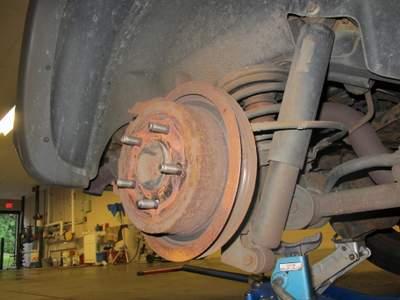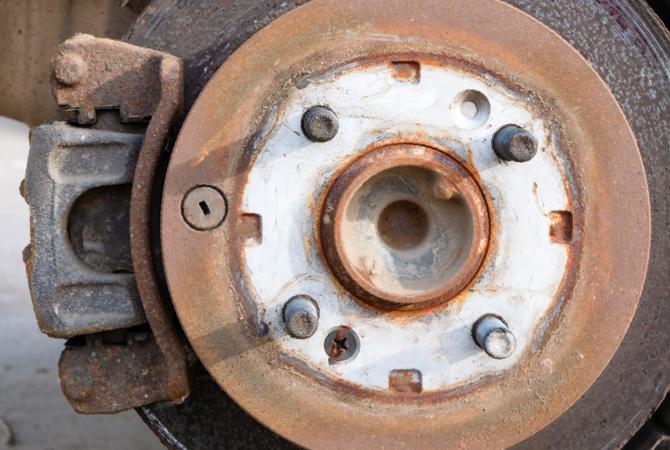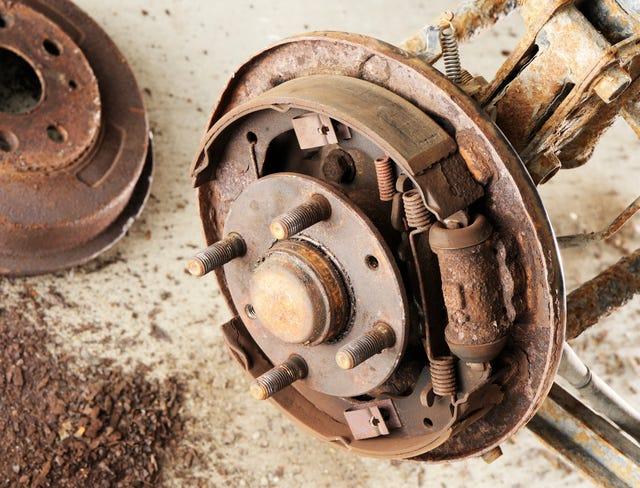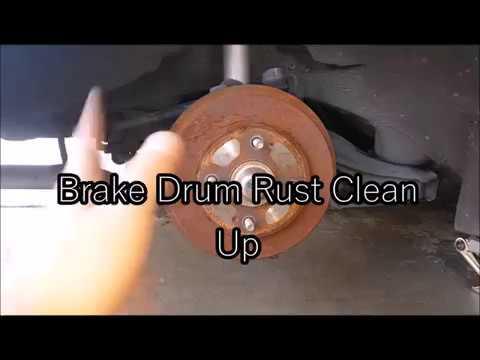Have you ever imagined how a little rust on a brake drum could lead to a life-altering event? Early in my career as a Jeep engineer, I witnessed an incident firsthand: a minor case of surface rust escalated into a dramatic braking failure during a routine test drive. This shocking moment sparked my commitment to understanding vehicle maintenance intricacies. Today, I share my insights about a seemingly humble component—brake drums—that’s often underestimated yet crucial for safety.
Rust on brake drums is a silent adversary that many vehicle owners face, yet few fully grasp its implications. This article explores the hidden dangers of rust on brake drums, shedding light on its causes, effects, and potential solutions. By deciphering these complexities, we can ensure our vehicles aren’t just running but are operating safely. Join me as we delve into the world of brake drum maintenance, a subject vital to both vehicle longevity and driver safety.
What is Rust on Brake Drums?

In my early days as an engineer, I frequently explained to new automotive technicians that a light coating of rust isn’t always a cause for alarm. This basic understanding was crucial, especially when dealing with brake drums. Did you know that nearly every vehicle equipped with steel brake drums faces some level of rust? It’s a reality that most car owners have to contend with at some point.
Brake drums, often made from steel or cast iron, are highly susceptible to rust due to their regular exposure to moisture and road salts. These corrosive elements can lead to surface rust, a common occurrence after events like rainy drives or prolonged periods of vehicle inactivity. I vividly recall a time with a prototype vehicle after a particularly grueling rainy test. We observed some surface rust and had to reassure the team that this was normal and would not compromise the drum structure.
While surface rust can typically be cleaned off without doing harm, it’s important to differentiate it from more serious rust that eats away at the metal over time. Understanding this distinction aids in proper maintenance and enhances the longevity of the brake system. This everyday challenge underscores the need for vigilance and appropriate care of brake drums to stave off more severe issues down the line.
Why Does Rust Develop on Brake Drums?

Throughout my career, I’ve encountered numerous vehicles burdened with rusty brake drums, a condition that always sparked my curiosity. What triggers the development of rust on components that should be built for durability?? It’s a question that delves into the heart of vehicle maintenance and preservation. While brake drums are forged from durable materials, they’re not immune to the persistent assaults of nature, namely moisture and prolonged inactivity.
I recall a specific instance during a field test with a Jeep that had sat idle for several months. Its brake drums were painted with an unexpected layer of rust, a stark testament to how exposure and stagnation can erode even the sturdiest components. This experience underscored a fundamental lesson for me: regular vehicle use and maintenance are vital in rust prevention.
Moisture, particularly when humidity seeps into garages or storage areas, forms a perfect storm with stagnant air. Brake drums, designed to weather tough conditions, begin to oxidize when left unchecked. Without motion to disperse and dry this moisture, it settles and catalyzes corrosion. There’s an undeniable irony in how inactivity, often mistaken for safety, invites the stealthy advance of rust. It is a reminder that our vehicles, like us, require movement and care to keep vitality and performance alive.
Who is Affected by Rust on Brake Drums?

Rust on brake drums affects more drivers than one might initially assume. From my extensive experience with vehicle testing at Jeep, I’ve witnessed firsthand how detrimental this issue can be. How does rust on a brake drum impact the safety of everyday drivers? This was starkly evident when an issue arose with one of our off-road prototypes; rust accumulation on the brake drums unexpectedly altered its braking performance. This was a wake-up call, underscoring the importance of vigilant brake maintenance.
I realized that the implications extended beyond the rugged terrains where our prototypes often roam. Everyday drivers, whether commuting to work or embarking on family road trips, could just as easily face compromised safety. Poor braking can exponentially increase the risk of accidents, a fact I’m acutely aware of given the rigorous standards we uphold in vehicle testing.
Hence, both casual drivers and off-road enthusiasts must prioritize brake drum care, acknowledging that rust isn’t just a cosmetic issue. It’s crucial for everyone on the road to recognize the potential hazards lurking in their braking systems and to take proactive measures against rust formation. As I learnt, staying vigilant is not just a best practice; it’s a part of ensuring safe journeys for everyone.
When to Address Rust on Brake Drums?

One of my key learnings came during a routine maintenance check when I witnessed how minor rust could quickly morph into a major problem if ignored. This experience reinforced to me the importance of vigilance. At what point should you take action against brake drum rust to avoid serious issues?? I often ask myself this vital question, because the answer can mean the difference between a simple fix and costly brake repairs.
I advise drivers to check their brake drums regularly, especially after winter months or extended periods of non-use. This period is when moisture and salt from the roads tend to wreak havoc, increasing the chances of a thin layer of rust forming. When you notice any rust—no matter how light—it’s time to act. Prompt cleaning can prevent it from penetrating deeper into the metal, averting more severe corrosion that compromises your vehicle’s safety. Regular inspection and maintenance are key to ensuring your brake drums remain in optimal condition and protect against serious repercussions down the line.
How to Remove Rust from Brake Drums?

During my years working with various brake systems, I’ve come across many daunting challenges, but none quite like the rust-covered brake drums on a classic Jeep that had been left to the mercy of the elements. This experience taught me that patience and precision are key when dealing with rust removal. It’s not just about cleaning; it’s about doing justice to the vehicle’s legacy while maintaining its mechanical integrity.
What are the best techniques to effectively eliminate rust from brake drums without causing damage? A question I have often pondered in my garage. From my practical insights, the blend of sandpaper methods and rust-inhibiting treatments was my salvation in preserving the drums. By carefully choosing a mild abrasive, such as 120-grit sandpaper, I was able to gently rub away the surface rust without scratching or weakening the metal.
After sanding, applying a rust-inhibitor could make all the difference; it acts as a shield, guarding the drums against future corrosion. Products containing phosphoric acid often bring about the best results, converting rust into a protective coating. Yet, in this process, I realized that taking my time was paramount. Rushing could lead to further damage, a hard lesson learned through earlier, less successful attempts.
This method isn’t solely about fixing a problem—it’s also about understanding and respecting the brake drum’s history and function. Each stroke of sandpaper, each moment spent ensuring the inhibitor is evenly spread, is a step towards maintaining the vehicle’s brilliance and safety on the road. As with any rust challenge, the diligence in preparation mirrors the satisfaction of witnessing pristine, rust-free brake drums—remnants of time transformed through careful effort.
What are the Solutions for Preventing Rust on Brake Drums?

Could implementing simple preventive solutions save you from costly repairs in the future? From my experience, preventative action is often the key to minimizing rust risk on brake drums. I vividly remember a Jeep I worked on that had brand new, treated brake drums installed. The owner was meticulous about regular cleaning and inspection, resulting in virtually no rust issues over several years. This memory underscores the vitality of utilizing quality materials and embracing diligent maintenance habits.
Investing in rust-resistant coatings can be one of the most effective strategies. These coatings, applied to new brake drums, act as a barrier against moisture and corrosive elements. I’ve seen firsthand how such treatments can extend the lifespan of brake components, offering peace of mind to vehicle owners. Additionally, ensure regular brake inspections during routine vehicle maintenance. This practice can catch early-stage rust before it progresses to more serious deterioration.
Moreover, simple habits like washing the undercarriage of your vehicle, especially after exposure to road salt or winter conditions, can make a significant difference. This is something I always advise my friends and clients to prioritize. Remember, consistent preventive measures are essential to safeguard your vehicle against the relentless march of rust. By staying proactive, you not only maintain the integrity of your brake drums but also avoid unnecessary repair costs down the line.
FAQs
What Causes Rust on Brake Drums?
Rust on brake drums is primarily caused by exposure to moisture and road salt. These elements accelerate the oxidation process on metal surfaces.
What Are the Effects of Rust on Brake Drums?
The presence of rust can compromise the structural integrity of brake drums, potentially leading to reduced braking efficiency and increased stopping distances.
How Can Rust on Brake Drums Be Prevented?
To prevent rust, it’s advisable to regularly clean and inspect brake components, apply anti-rust sprays, and store vehicles in dry environments when not in use.
What Are the Solutions for Rusted Brake Drums?
Solutions for rusted brake drums include using a rust remover or cleaner, replacing severely corroded drums, and applying a protective coating to prevent future rust formation.
Conclusion
What is the overarching takeaway about the importance of addressing rust on brake drums? Through my experiences, such as when I first spotted rust on my Jeep’s brake drums, I realized tackling minor issues early on is crucial. Rust not only affects vehicle performance but also compromises safety—a lesson I’ve learned firsthand. Regular maintenance and vigilance are essential in keeping your vehicle running smoothly and safely. The solutions we explored, from regular cleaning to protective coatings, are simple yet effective. By understanding the causes and impacts of rust, we can ensure a safer driving experience and prolonged brake drum life.